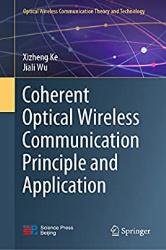 Название: Coherent Optical Wireless Communication Principle and Application
Название: Coherent Optical Wireless Communication Principle and ApplicationАвтор: Xizheng Ke, Jiali Wu
Издательство: Springer/Science Press
Год: 2022
Страниц: 474
Язык: английский
Формат: pdf (true)
Размер: 17.6 MB
This book presents the key technologies of coherent optical wireless communication, covers topics such as beam coupling, signal optical polarization control and distorted wavefront correction. It discusses the principle of coherent optical communication and heterodyne detection conditions. In this book, the array coupling receiving technology and large aperture coupling technology are introduced to realize the spatial optical fiber coupling; simulated annealing algorithm, particle swarm optimization algorithm and SPO algorithm are used to control the polarization state of the signal beam; and the correction of distorted wavefront of the signal beam by adaptive optics technology and wavefront sensorless adaptive optics technology are analyzed, and the influence of beam mode on coherent detection performance is elaborated. Both theoretical deduction and experimental results are included in this book, which can help readers further understand the theoretical knowledge.
The rapid development of Artificial Intelligence (AI) has resulted in higher requirements for the communication industry. The optical communication industry is focusing on larger channel capacities, longer transmission distances, higher data transmission rates, and better transmission quality. The intensity modulation/direct detection method adopted by the traditional optical communication technology cannot cope with this high-speed communication, owing to its limited single-channel bandwidth.
Coherent optical communication is favored by researchers because of its unique advantages of rich modulation modes, large communication capacity, and high receiving sensitivity. It can fundamentally improve the selectivity of the receiver and increase the relay-free transmission distance of optical signals. To achieve more accurate, effective, and reliable coherent optical communication, breakthroughs are needed in corresponding key technologies, such as carrier frequency stability, beam coupling, and the correction of the polarization direction and wavefront distortion of the signal light at the receiving end.
Free-space optical communication (FSOC), also known as optical wireless communication (WOC), is a communication technology that uses laser beams as information carriers to directly transmit data, audio, and video signals in space. With the development of the high-capacity, long-distance communication technology, WOC has broad application prospects in the fields of inter-satellite communication and the last-kilometer access of local networks. Therefore, WOC has become a research hotspot in optical communication technology. Generally, WOC adopts intensity modulation/direct detection (IM/DD) and subcarrier modulation (SCM)/DD. IM refers to the use of the intensity of light to carry information, including the on–off keying (OOK) mode and pulse-position modulation (PPM) mode. DD refers to direct detection, using a photoelectric detector, of the intensity of a laser converging on a photosensitive surface. The IM/DD mode has the advantages of its simple principle and low cost; however, it has the disadvantages of low frequency band utilization and poor reception sensitivity. In SCM, the binary bit information is modulated to the carrier frequency. Thereafter, the modulated subcarrier is used to modulate the optical carrier. This modulation technology can use the spectrum resources effectively through the wavelength division multiplexing technology and improve the capacity of transmission.
The book is divided into nine chapters, which provide an overview of optical wireless coherent detection, coherent optical communication, spatial optical-fiber coupling and beam control, beam polarization control technology, double-balanced detection, adaptive optics correction, wavefront sensorless correction, spatial coherent optical communication wavefront correction of LC-SLM-R, and the influence of the beam mode on the performance of coherent detection systems. The principles and key technologies of coherent optical wireless communication are also introduced. Array coupling reception and large aperture coupling are proposed for spatial optical coupling. To improve the mixing efficiency of coherent detection receivers, signal optical polarization control and adaptive optics technology are proposed.
This book is suitable for engineering and technical personnel, college and university teachers, graduate students and undergraduate students in their final year, who are engaged in the field of optical wireless communication.
Contents:
1. Optical Wirelss Coherent Detection: An Overview
2. Coherent Optical Communication
3. Spatial Light to Fiber Coupling and Beam Control
4. Beam Polarization Control Technology
5. Double Balanced Detection.-Wavefont Correction System
6. Adaptive Optics Correction
7. Wavefont Sensorless Adaptive Optics Correction
8. Wavefont Correction Technique of Spatial Coherent Optical Communication with LC-SLM
9. Effect of Beam Mode on Coherent Detection System
Скачать Coherent Optical Wireless Communication Principle and Application